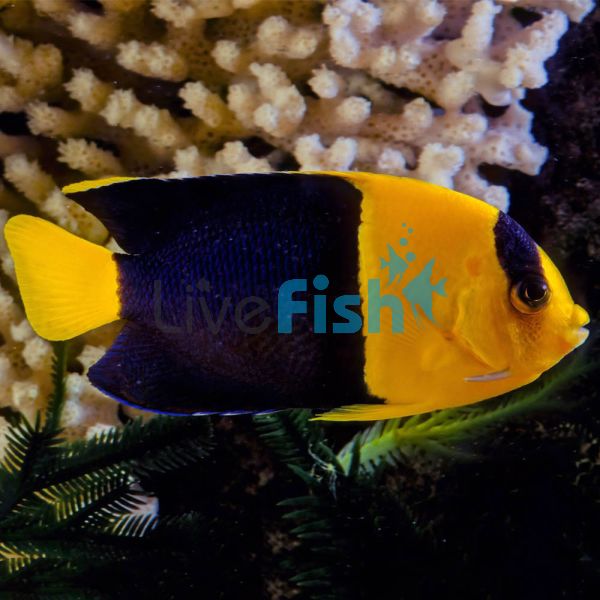Bi-colour Angelfish - Medium
The Bicolour Angelfish, also known as the Blue & Gold Angelfish, has a yellow head and tail, with a blue/dark blue back half. This Dwarf Angelfish is aggressive in nature and is recommended as a challenge for experienced aquarists.
A pair of Bicolour Angelfish will bring a lot of colour and energy to your aquarium.
Bi-colour Angelfish
Recognizable by its bright yellow tail and front half, a rear with blue patterns, plus a blue mask above the eyes. The typical life expectancy is 5–15 years in the aquarium.
Males and females haven't any color distinction. Male Bicolor Angelfish visit females at dusk to mate. A male may visit many females per night to spawn. Male Bicolor Angelfish can have harems of up to 7 females, the biggest being the most dominant. If the male disappears, then the most dominant female will change sex and take over the harem.
Bicolour Angelfish are aggressive - both to members of other species and their own. Males spend most of their time guarding their territory. His territory encompasses the territory of all females within the group. The females are only aggressive towards the lower-ranking members of their own group.
Bicolour Angelfish habitats include lagoons, drop-off areas of reef slopes, and coral areas. The Bicolour grows to 6 inches long, which makes them a dwarf angelfish.
The Bicolor Angelfish is moderately difficult to keep and good for intermediate aquarists. They're among the most aggressive dwarf angelfish, so choose tankmates wisely. Add Dwarf angels together and be the last fish introduced to the tank.
Tank Recommendations for Bicolour Angelfish
They need a bigger tank size, of at least 75 gallons. If keeping a mated pair then 75 to 100 gallons would be appropriate, and over 150 for two unsexed fish. A longer tank, instead of taller, is better because they swim near the bottom-most of the time. Providing live rock with lots of hiding places, especially near the bottom of the tank, will keep them happy. Set up your tank for 6 months before adding the Bicolor Angelfish to allow algae growth on the live rock.
Dwarf angelfish can be kept with toxic corals as it won’t eat them. Leather Coral families like Sinularia, Sarcophytom, Paralemnalia, and Cladiella are fine. You can keep snails, crabs, and large shrimp with them, but it's best if they're added to the tank before the fish.
Water conditions 22.2-25.5° C (72-78° F), dKH 8-12, pH 8.1-8.4, sg 1.020-1.025.
Be cautious about introducing to a reef tank as these guys love to snack on tube worms.
Suitable Tank Buddies
Keeping the Bicolour with other dwarf Angelfish should only be in a tank over 100 gallons, up to 150 gallons. It’s best to ensure that the other dwarf Angelfish are of different color, size (larger, not smaller), and shape.
Adding the Bicolour to the tank last is recommended. Snails, crabs, and large shrimps are usually okay, but it is best if these are added to the tank before the Angelfish.
Usually Compatible
Large semi-aggressive and aggressive species such as Damselfish, large Wrasses, Tangs. If it will not fit into the mouths of Lionfish and Groupers, then these are all good choices for a drama-free tank.
Sometime Compatible
Smaller fish such as Anthias, Clownfish, and other Dwarf Angels, need plenty of places to hide to avoid harassment. They may also nip leather corals, soft corals, and pipe corals, it's best kept with live rock with algae. The Bicolour can be kept with other Bicolours in a tank of over 75-100 gallons for a pair or over 150 gallons for two unsexed individuals.
Rarely Compatible
Incompatible species are any predatory fish large enough to fit the Bicolour in their mouths. Peaceful slow-swimming fish like Gobies, Dartfish, Fairy wrasses, Seahorses, and Pipefish. Sponges, tunicates, clams, scallops, and oysters will get nipped at so won't do well.
Feeding Your Bicolour Angelfish
Bicolor is omnivores like most angelfish. A typical bicolor angelfish diet consists of small crustaceans like brine and mysis shrimp. Tunicates, corals, sponges, worms, algae, and sometimes clams also make up some of their diets. You can feed your fish a diet of Spirulina, marine algae, high-quality angelfish preparations, and mysis or frozen shrimp. Bicolor Angelfish are likely to nip at stony and soft corals and clam mantles.
| Scientific Name | Centropyge Bicolour |
|---|---|
| Care Level | Moderate |
| Common Names | Two-coloured Angelfish, Blue and Gold Angel, Oriole Angelfish |
| Diet | Omnivore |
| Fish Family | Pomacanthidae |
| Lifespan (years) | 9 |
| Max. Length (cm) | 15 |
| Min. Tank Volume (l) | 55 |
| Origin | Indo-Pacific |
| Reef Safe | With Caution |
| Sociability | Aggressive |
| Venomous | No |
| Water Conditions | 23 - 28° C , dKH 8-12, pH 8.0-8.4, sg 1.023-1.025 |
| Plant Safe | No |




